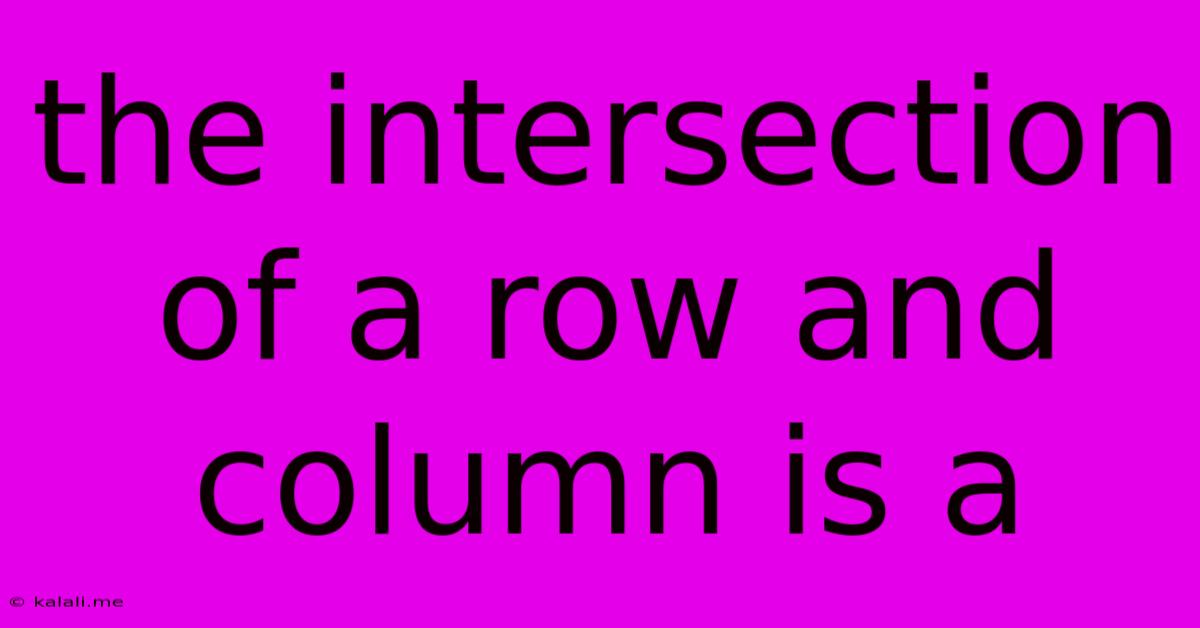The Intersection Of A Row And Column Is A
Kalali
Jun 12, 2025 · 3 min read

Table of Contents
The Intersection of a Row and Column Is a: Cell
The seemingly simple question, "The intersection of a row and column is a...?" reveals a fundamental concept in data organization and structure, particularly relevant to spreadsheets, databases, and tables in general. The answer, of course, is a cell. This seemingly basic element forms the building block of how we organize and manipulate data. This article will delve deeper into the significance of cells and their role in various data structures.
Understanding the concept of a cell is crucial for anyone working with data, whether you're creating a simple spreadsheet for personal budgeting, designing a complex database for a large corporation, or even understanding the underlying structure of HTML tables on a website.
What is a Cell?
A cell is the smallest unit of data within a structured data format like a table, spreadsheet, or database. It represents the intersection of a single row and a single column. Each cell can contain a single piece of data, which could be:
- Text: Words, sentences, or any alphanumeric characters.
- Numbers: Integers, decimals, or any numerical value.
- Dates: Formatted according to the specific software or system.
- Formulas: Expressions that perform calculations based on data in other cells.
- Boolean Values: True or False.
- Blank: An empty cell containing no data.
The Significance of Cells in Data Organization
The organization of data into rows and columns, with each intersection representing a cell, allows for several key advantages:
- Structured Data: Cells provide a clear and structured way to organize data, making it easy to read, understand, and manipulate.
- Data Manipulation: Spreadsheets and databases offer powerful tools to manipulate data within cells, including sorting, filtering, and performing calculations.
- Data Relationships: Cells allow for the establishment of relationships between different pieces of data. For example, a formula in one cell can reference data from other cells, enabling complex calculations and analysis.
- Data Integrity: The structured nature of cells promotes data integrity by ensuring that each piece of data is stored in a designated location.
- Scalability: Tables and databases can easily accommodate large datasets because the cell structure allows for the efficient storage and retrieval of information.
Cells Across Different Applications
The concept of a cell applies across many applications:
- Spreadsheets (e.g., Microsoft Excel, Google Sheets): The most common example, where cells are used to input and manipulate data.
- Databases (e.g., MySQL, PostgreSQL): Data is organized into tables consisting of rows and columns, with each intersection forming a cell.
- HTML Tables: Websites often use tables to organize data in a visually appealing way, employing the same fundamental concept of rows, columns, and cells.
- Programming: Arrays and matrices in programming often utilize the same row-column structure.
Conclusion
In conclusion, the intersection of a row and a column is a cell, a fundamental concept underlying the organization and manipulation of data in various applications. Understanding cells is essential for anyone working with spreadsheets, databases, or any system dealing with tabular data. The simple cell forms the bedrock of efficient data management and analysis in the modern world.
Latest Posts
Latest Posts
-
How Many Molecules In 1 Mole Of Water
Jun 13, 2025
-
What Is The Largest Ecosystem On Earth
Jun 13, 2025
-
Fire Safety Test Questions And Answers Pdf
Jun 13, 2025
-
Which Of The Following Has The Greatest Momentum
Jun 13, 2025
-
Are Metals On The Right Side Of The Periodic Table
Jun 13, 2025
Related Post
Thank you for visiting our website which covers about The Intersection Of A Row And Column Is A . We hope the information provided has been useful to you. Feel free to contact us if you have any questions or need further assistance. See you next time and don't miss to bookmark.